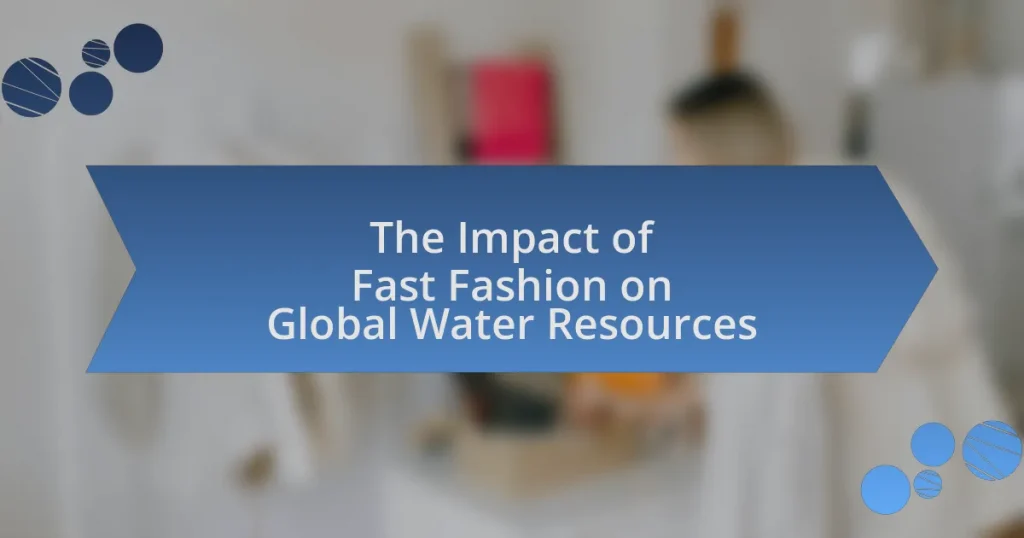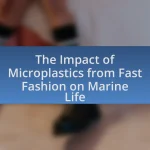The article examines the significant impact of fast fashion on global water resources, highlighting excessive water consumption and pollution associated with the industry. It details that the production of a single cotton t-shirt requires approximately 2,700 liters of water and that the fashion industry is responsible for about 20% of global wastewater. The article discusses the main pollutants linked to fast fashion, including synthetic dyes and microplastics, and their detrimental effects on aquatic ecosystems and human health. Additionally, it addresses the implications of high water usage for local communities, particularly in regions facing water scarcity, and explores potential solutions for mitigating these environmental challenges.
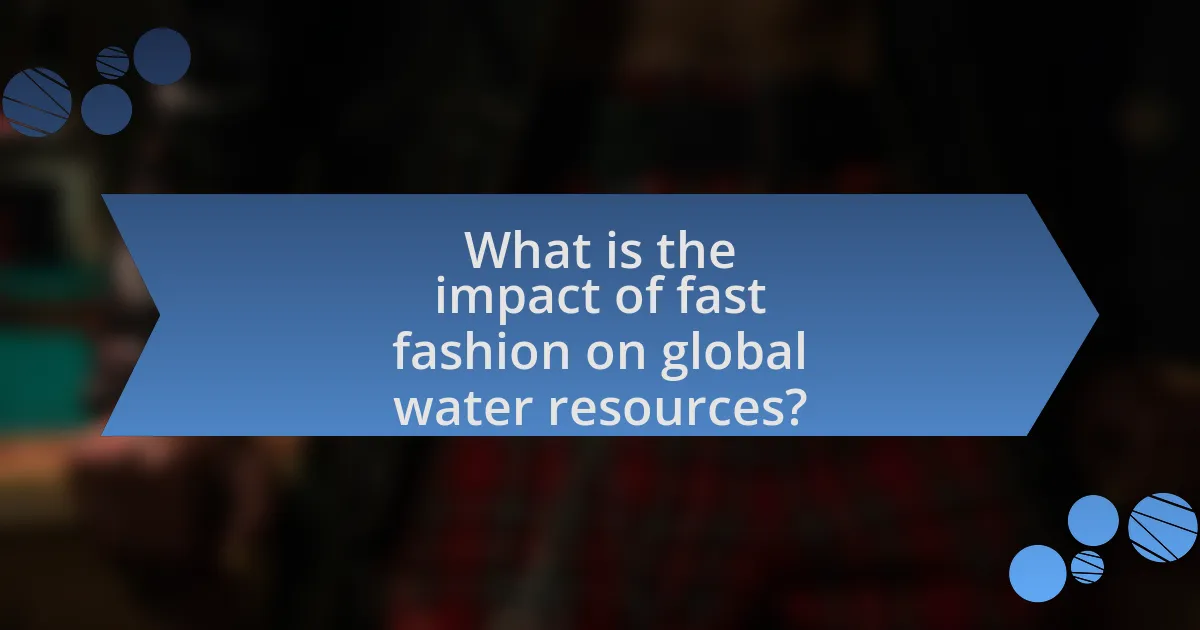
What is the impact of fast fashion on global water resources?
Fast fashion significantly depletes global water resources through excessive water consumption and pollution. The production of a single cotton t-shirt requires approximately 2,700 liters of water, which is enough for one person to drink for two and a half years. Additionally, fast fashion contributes to water pollution; the dyeing and finishing processes release toxic chemicals into waterways, affecting aquatic ecosystems and drinking water supplies. According to the United Nations, the fashion industry is responsible for 20% of global wastewater, highlighting its detrimental impact on water quality and availability.
How does fast fashion contribute to water pollution?
Fast fashion contributes to water pollution primarily through the excessive use of water in textile production and the discharge of untreated wastewater. The fashion industry is responsible for approximately 20% of global wastewater, as it requires vast amounts of water for dyeing and finishing processes. Additionally, many fast fashion brands often release toxic chemicals, including dyes and heavy metals, into water bodies without proper treatment, leading to contamination of local water sources. This pollution adversely affects aquatic ecosystems and can harm human health, as contaminated water can enter drinking supplies.
What are the main pollutants associated with fast fashion production?
The main pollutants associated with fast fashion production include synthetic dyes, microplastics, and heavy metals. Synthetic dyes, commonly used in textile manufacturing, can contaminate water sources, with an estimated 20% of global water pollution attributed to the dyeing process. Microplastics, shed from polyester and other synthetic fabrics during washing, contribute significantly to ocean pollution, with millions of tons entering marine environments annually. Heavy metals, such as lead and mercury, often found in dyes and finishing agents, pose serious health risks to aquatic life and humans. These pollutants collectively harm ecosystems and compromise water quality, highlighting the environmental impact of fast fashion on global water resources.
How do these pollutants affect aquatic ecosystems?
Pollutants from fast fashion significantly harm aquatic ecosystems by introducing toxic substances that disrupt the health of water bodies. These pollutants, including dyes, microplastics, and heavy metals, can lead to decreased oxygen levels, harming aquatic life and reducing biodiversity. For instance, a study published in the journal Environmental Science & Technology found that textile dyes can be lethal to fish and other aquatic organisms, causing mortality rates to rise significantly in contaminated waters. Additionally, microplastics can accumulate in the food chain, affecting not only aquatic species but also the animals and humans that consume them.
What is the water consumption associated with fast fashion?
Fast fashion is associated with significant water consumption, estimated at around 2,700 liters of water to produce a single cotton t-shirt. This high water usage stems from the extensive agricultural practices required for cotton cultivation, which is a primary material in fast fashion. Additionally, the dyeing and finishing processes in garment manufacturing further contribute to water consumption, with the industry collectively using approximately 93 billion cubic meters of water annually. This level of water usage has severe implications for global water resources, particularly in regions already facing water scarcity.
How much water is used in the production of a single garment?
The production of a single garment typically uses about 2,700 liters of water. This figure is derived from the water-intensive processes involved in growing cotton, dyeing, and finishing the fabric. For instance, it takes approximately 7,000 liters of water to produce one kilogram of cotton, which is a common material in clothing. This statistic highlights the significant water footprint associated with garment production, emphasizing the environmental impact of the fast fashion industry on global water resources.
What are the implications of high water usage for local communities?
High water usage has significant implications for local communities, primarily leading to water scarcity and environmental degradation. When communities experience high water consumption, especially due to industries like fast fashion, the demand often exceeds the natural replenishment rate of local water sources. For instance, the fashion industry is responsible for consuming approximately 93 billion cubic meters of water annually, which can deplete local aquifers and rivers, affecting the availability of water for drinking, agriculture, and sanitation. This depletion can result in increased competition for water resources, exacerbating social tensions and economic disparities within communities. Furthermore, high water usage can lead to pollution, as runoff from textile production often contaminates local water bodies, impacting both human health and local ecosystems.
Why is water scarcity a concern in fast fashion production regions?
Water scarcity is a concern in fast fashion production regions because these areas often rely on significant water resources for textile manufacturing, dyeing, and finishing processes. The fast fashion industry is characterized by rapid production cycles and high demand, leading to excessive water consumption. For instance, it takes approximately 7,000 liters of water to produce a single pair of jeans, exacerbating water shortages in regions already facing limited water availability. Additionally, the pollution from dyeing processes contaminates local water supplies, further diminishing access to clean water for communities. This combination of high water usage and pollution creates a critical situation for both the environment and local populations dependent on these water resources.
What regions are most affected by water scarcity due to fast fashion?
The regions most affected by water scarcity due to fast fashion are primarily South Asia, particularly India and Bangladesh, as well as parts of Central Asia and the Middle East. In India, the textile industry consumes approximately 2,700 liters of water to produce a single cotton t-shirt, exacerbating water shortages in already stressed areas like Rajasthan. Bangladesh faces similar challenges, where the garment sector accounts for a significant portion of water usage, leading to depletion of local water sources. Central Asia, especially countries like Uzbekistan, suffers from water scarcity linked to cotton production, which is heavily influenced by fast fashion demands. The Middle East, with its arid climate, also experiences heightened water stress due to the water-intensive nature of textile manufacturing.
How does fast fashion exacerbate existing water scarcity issues?
Fast fashion exacerbates existing water scarcity issues by significantly increasing water consumption and pollution in textile production. The fast fashion industry requires vast amounts of water for processes such as dyeing and finishing fabrics, with estimates suggesting that producing a single cotton t-shirt can consume up to 2,700 liters of water. This high demand for water strains local water resources, particularly in regions already facing scarcity. Additionally, the discharge of untreated wastewater from factories contaminates freshwater sources, further diminishing the availability of clean water for communities. According to the World Bank, the textile industry is responsible for about 20% of global wastewater, highlighting its detrimental impact on water quality and availability.
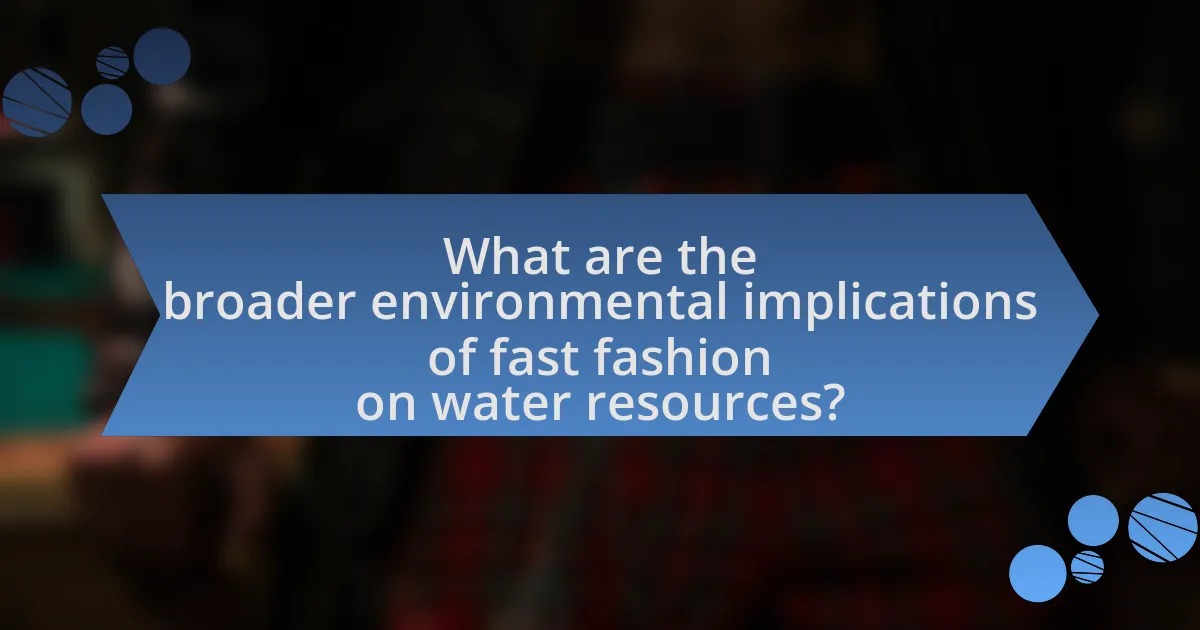
What are the broader environmental implications of fast fashion on water resources?
Fast fashion significantly depletes water resources, leading to severe environmental implications. The industry consumes approximately 93 billion cubic meters of water annually, which is enough to meet the needs of five million people. This excessive water usage contributes to the depletion of freshwater sources, particularly in regions already facing water scarcity. Additionally, the dyeing and finishing processes in fast fashion often pollute water bodies with toxic chemicals, adversely affecting aquatic ecosystems and human health. Studies indicate that textile production is responsible for 20% of global wastewater, exacerbating the pollution of rivers and lakes. Thus, fast fashion not only strains water resources but also compromises water quality, posing a threat to both the environment and communities reliant on these water sources.
How does fast fashion impact global water cycles?
Fast fashion significantly disrupts global water cycles by increasing water consumption and pollution. The production of fast fashion garments requires vast amounts of water; for instance, it takes approximately 2,700 liters of water to produce a single cotton t-shirt. This high demand for water can lead to the depletion of local water sources, affecting ecosystems and communities reliant on these resources. Additionally, the dyeing and finishing processes in fast fashion contribute to water pollution, as toxic chemicals are often released into waterways, further degrading water quality and impacting aquatic life. Studies indicate that the fashion industry is responsible for about 20% of global wastewater, exacerbating the strain on water cycles and contributing to environmental degradation.
What role does fast fashion play in altering precipitation patterns?
Fast fashion contributes to altering precipitation patterns primarily through its significant carbon emissions and land use changes. The production processes associated with fast fashion, including manufacturing and transportation, release large amounts of greenhouse gases, which are known to influence climate change and subsequently affect precipitation patterns. For instance, a study by the United Nations Environment Programme indicates that the fashion industry is responsible for about 10% of global carbon emissions, which can lead to shifts in weather patterns, including altered rainfall distribution. Additionally, the extensive use of water resources for cotton cultivation and dyeing processes can lead to land degradation, further impacting local climates and precipitation.
How does it affect groundwater levels?
Fast fashion significantly lowers groundwater levels due to excessive water extraction for textile production. The industry consumes approximately 93 billion cubic meters of water annually, leading to depletion of aquifers in regions like Central Asia and India, where water resources are already stressed. This over-extraction disrupts the natural replenishment of groundwater, resulting in long-term ecological consequences and reduced availability for local communities.
What are the social implications of fast fashion’s water usage?
Fast fashion’s water usage has significant social implications, particularly affecting communities in water-scarce regions. The industry consumes approximately 2,700 liters of water to produce a single cotton t-shirt, which exacerbates water scarcity for local populations reliant on these resources for drinking and agriculture. This over-extraction of water can lead to conflicts over water rights, as communities face reduced access to clean water, impacting their health and livelihoods. Furthermore, the pollution from textile production, often discharged into local waterways, can lead to severe health issues for nearby residents, including skin diseases and respiratory problems. Studies have shown that in countries like Bangladesh, where fast fashion is prevalent, the combination of water scarcity and pollution has resulted in increased poverty and social unrest, highlighting the urgent need for sustainable practices in the fashion industry.
How does fast fashion affect the livelihoods of communities dependent on water resources?
Fast fashion negatively impacts the livelihoods of communities dependent on water resources by depleting local water supplies and polluting water sources. The fast fashion industry requires vast amounts of water for textile production, with estimates suggesting that producing a single cotton t-shirt can consume up to 2,700 liters of water. This high demand can lead to water scarcity in regions where communities rely on these resources for drinking, agriculture, and sanitation. Additionally, the discharge of untreated wastewater from textile factories contaminates local water bodies, harming aquatic ecosystems and affecting the health and livelihoods of nearby populations. Studies have shown that in countries like Bangladesh, where fast fashion is prevalent, water pollution from garment factories has led to significant health issues and economic challenges for local communities.
What are the health impacts on populations living near fast fashion production sites?
Populations living near fast fashion production sites experience significant health impacts, primarily due to exposure to toxic chemicals and pollutants. These production facilities often release hazardous substances, such as dyes, solvents, and heavy metals, into the air and water, leading to respiratory issues, skin diseases, and other health problems among nearby residents. For instance, a study published in the journal Environmental Science & Technology found that textile manufacturing contributes to water pollution, which can cause gastrointestinal diseases and reproductive health issues in affected communities. Additionally, the World Health Organization has reported that air pollution from industrial emissions can exacerbate conditions like asthma and cardiovascular diseases, further highlighting the detrimental health effects on populations near these sites.
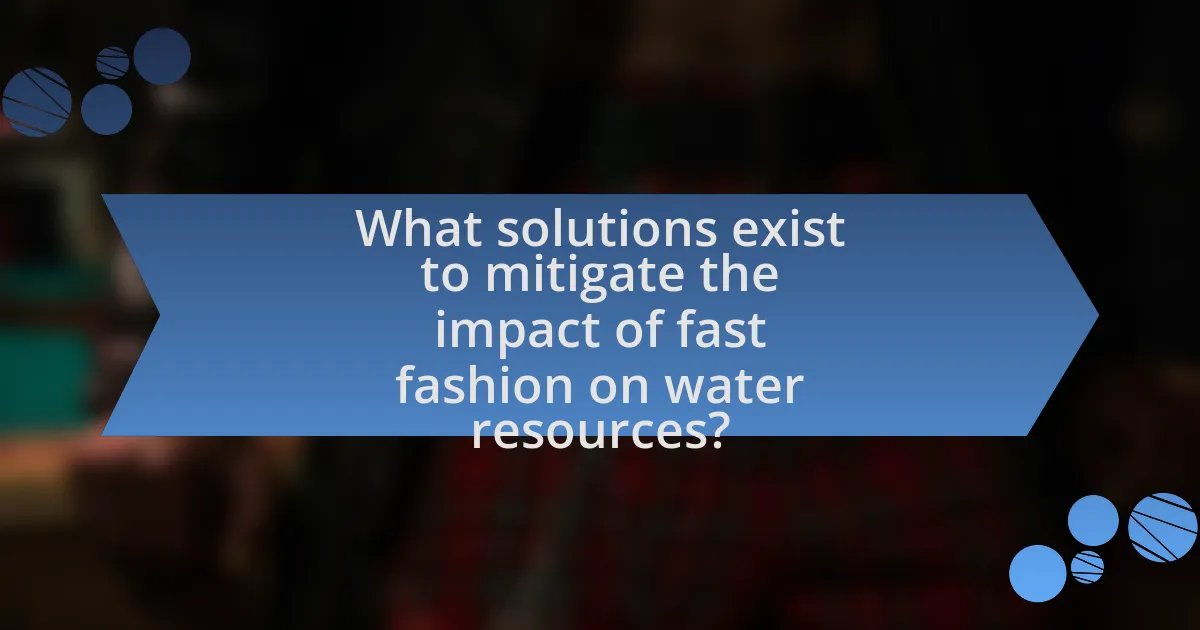
What solutions exist to mitigate the impact of fast fashion on water resources?
Solutions to mitigate the impact of fast fashion on water resources include implementing sustainable manufacturing practices, promoting water-efficient technologies, and encouraging consumer awareness and behavior change. Sustainable manufacturing practices, such as using organic materials and closed-loop systems, can significantly reduce water consumption and pollution. For instance, the use of waterless dyeing technologies can decrease water usage by up to 90%. Additionally, promoting water-efficient technologies in textile production can help minimize water waste. Consumer awareness campaigns can also drive demand for sustainable fashion, leading brands to adopt practices that prioritize water conservation. These strategies collectively address the excessive water use and pollution associated with fast fashion.
How can consumers reduce their water footprint related to fast fashion?
Consumers can reduce their water footprint related to fast fashion by choosing sustainable clothing options, such as buying from brands that prioritize water-efficient production methods. Sustainable brands often utilize techniques like waterless dyeing and organic materials, which significantly lower water usage. For instance, the fashion industry is responsible for approximately 20% of global wastewater, highlighting the importance of mindful purchasing. Additionally, consumers can extend the lifespan of their clothing by washing less frequently and opting for cold water washes, which further conserves water. By making these conscious choices, consumers can effectively mitigate the water impact associated with fast fashion.
What practices can consumers adopt to make more sustainable fashion choices?
Consumers can adopt several practices to make more sustainable fashion choices, including buying second-hand clothing, choosing brands that prioritize sustainability, and reducing overall consumption. By purchasing second-hand items, consumers extend the life cycle of garments, which helps mitigate the environmental impact associated with producing new clothing. Research indicates that the fashion industry is responsible for 20% of global wastewater, highlighting the importance of reducing demand for new products. Additionally, selecting brands that utilize eco-friendly materials and ethical production methods can significantly decrease water usage and pollution. Finally, consumers can practice mindful shopping by evaluating their needs and opting for quality over quantity, which contributes to a more sustainable fashion ecosystem.
How can consumers advocate for better water management in the fashion industry?
Consumers can advocate for better water management in the fashion industry by supporting brands that prioritize sustainable practices and transparency in their water usage. By choosing to purchase from companies that implement water-efficient technologies and disclose their water management strategies, consumers can drive demand for responsible practices. Research indicates that the fashion industry is responsible for 20% of global wastewater, highlighting the urgent need for improved water management. Additionally, consumers can participate in campaigns and initiatives that promote water conservation, such as signing petitions or engaging in social media advocacy to raise awareness about the issue.
What role do brands play in addressing water resource issues?
Brands play a crucial role in addressing water resource issues by implementing sustainable practices and promoting water conservation initiatives. For instance, many fashion brands are adopting water-efficient production techniques, such as using less water in dyeing processes, which can reduce water consumption by up to 90%. Additionally, brands are increasingly investing in technologies that recycle water during manufacturing, thereby minimizing waste and protecting local water supplies. A notable example is Levi Strauss & Co., which has developed the Water Brands are implementing various initiatives to reduce water usage, including adopting water-efficient technologies, recycling water in production processes, and utilizing sustainable materials that require less water. For instance, companies like Levi Strauss & Co. have introduced the Water Brands can improve transparency regarding their water consumption practices by publicly disclosing detailed water usage data and implementing third-party audits. By providing specific metrics on water consumption across their supply chains, brands can foster accountability and build consumer trust. For instance, the Global Reporting Initiative (GRI) encourages companies to report on water usage, which can lead to better resource management and informed consumer choices. Additionally, brands can adopt initiatives like the Water Stewardship Standard, which outlines best practices for sustainable water management, further enhancing their commitment to transparency. The best practices for sustainable fashion production include using eco-friendly materials, implementing efficient water management, and adopting ethical labor practices. Eco-friendly materials, such as organic cotton and recycled polyester, reduce environmental impact by minimizing chemical use and waste. Efficient water management practices, like closed-loop systems, can significantly decrease water consumption and pollution, addressing the critical issue of water resources affected by fast fashion. Ethical labor practices ensure fair wages and safe working conditions, promoting social sustainability. These practices collectively contribute to a more sustainable fashion industry, mitigating the negative effects of fast fashion on global water resources. Technology can significantly reduce water usage in fashion manufacturing through innovations such as waterless dyeing techniques and advanced recycling systems. For instance, companies like DyeCoo have developed a waterless dyeing process that uses supercritical carbon dioxide instead of water, resulting in up to 90% less water consumption compared to traditional dyeing methods. Additionally, technologies like closed-loop water systems enable the recycling of water within manufacturing processes, minimizing waste and further decreasing overall water usage. These advancements not only conserve water but also enhance the sustainability of the fashion industry. Adopting circular fashion models significantly benefits water conservation by reducing water usage throughout the textile production process. Circular fashion emphasizes recycling and reusing materials, which minimizes the need for virgin resources that require substantial water for cultivation and processing. For instance, the production of one cotton t-shirt can consume up to 2,700 liters of water; by utilizing recycled fibers, circular models can drastically lower this demand. Additionally, circular fashion reduces wastewater generation, as it promotes cleaner production techniques and the use of non-toxic dyes, which helps protect water quality. This approach not only conserves water but also mitigates the environmental impact associated with traditional linear fashion models, which are responsible for significant water pollution and depletion.What initiatives are brands implementing to reduce water usage?
How can brands improve transparency regarding their water consumption practices?
What are the best practices for sustainable fashion production?
How can technology help reduce water usage in fashion manufacturing?
What are the benefits of adopting circular fashion models for water conservation?










